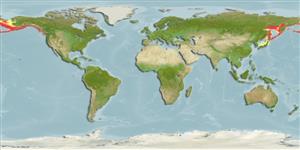Environment: milieu / climate zone / depth range / distribution range
Écologie
marin démersal; profondeur 0 - 700 m (Ref. 50593), usually ? - 91 m (Ref. 2850). Temperate; 67°N - 35°N, 130°E - 125°W (Ref. 54599)
North Pacific: Korea and the Sea of Japan to the Sea of Okhotsk, Bering Sea, and Barkley Sound, Canada. Reported from the Alaskan Beaufort Sea (Ref. 28503).
Length at first maturity / Taille / Poids / Âge
Maturity: Lm 27.3, range 21 - 32 cm
Max length : 49.0 cm TL mâle / non sexé; (Ref. 56370); common length : 33.5 cm TL mâle / non sexé; (Ref. 4883); poids max. publié: 1.7 kg (Ref. 56527); âge max. reporté: 34 années (Ref. 55701)
Épines dorsales (Total): 0; Rayons mous dorsaux (Total): 61-69; Épines anales 0; Rayons mous anaux: 48 - 58; Vertèbres: 39 - 40. Dorsal origin above posterior part of eye. Caudal rounded at edges. Pectorals bluntly pointed.
Adults feed on hydroids, worms, mollusks, and brittle stars (Ref. 6885). Marketed frozen and eaten fried, microwaved and baked (Ref. 9988).
Each individual spawns from 8 to 11 batches (Ref. 39301). Spawning occurs primarily in shallow water but for large females spawning may take place in waters to a depth of around 50 m (Ref. 119537). Undergoes spawning and feeding migration (Ref. 119537).
Vinnikov, K.A., R.C. Thomson and T.A. Munroe, 2018. Revised classification of the righteye flounders (Teleostei: Pleuronectidae) based on multilocus phylogeny with complete taxon sampling. Molecular phylogenetics and evolution, 125:147-162. (Ref. 122998)
Statut dans la liste rouge de l'IUCN (Ref. 130435)
Menace pour l'homme
Harmless
Utilisations par l'homme
Pêcheries: hautement commercial; pêche sportive: oui
Outils
Articles particuliers
Télécharger en XML
Sources Internet
Estimates based on models
Preferred temperature (Ref.
123201): 0.2 - 6.1, mean 3.4 °C (based on 33 cells).
Phylogenetic diversity index (Ref.
82804): PD
50 = 0.5156 [Uniqueness, from 0.5 = low to 2.0 = high].
Bayesian length-weight: a=0.00832 (0.00722 - 0.00958), b=3.08 (3.04 - 3.12), in cm total length, based on LWR estimates for this species (Ref.
93245).
Niveau trophique (Ref.
69278): 3.5 ±0.1 se; based on diet studies.
Generation time: 7.8 (6.8 - 11.0) years. Estimated as median ln(3)/K based on 12
growth studies.
Résilience (Ref.
120179): Faible, temps minimum de doublement de population : 4,5 à 14 années (K=0.1-0.15; tm=4-10; tmax=34; Fec=1 million).
Prior r = 0.33, 95% CL = 0.22 - 0.50, Based on 5 stock assessments.
Fishing Vulnerability (Ref.
59153): Moderate to high vulnerability (50 of 100).
Climate Vulnerability (Ref.
125649): Low vulnerability (23 of 100).
Nutrients (Ref.
124155): Calcium = 12.4 [5.7, 51.3] mg/100g; Iron = 0.246 [0.127, 0.464] mg/100g; Protein = 15.7 [13.4, 18.4] %; Omega3 = 0.36 [0.18, 0.74] g/100g; Selenium = 13.5 [4.6, 46.8] μg/100g; VitaminA = 9.24 [1.88, 45.54] μg/100g; Zinc = 0.298 [0.160, 0.721] mg/100g (wet weight); based on
nutrient studies.
